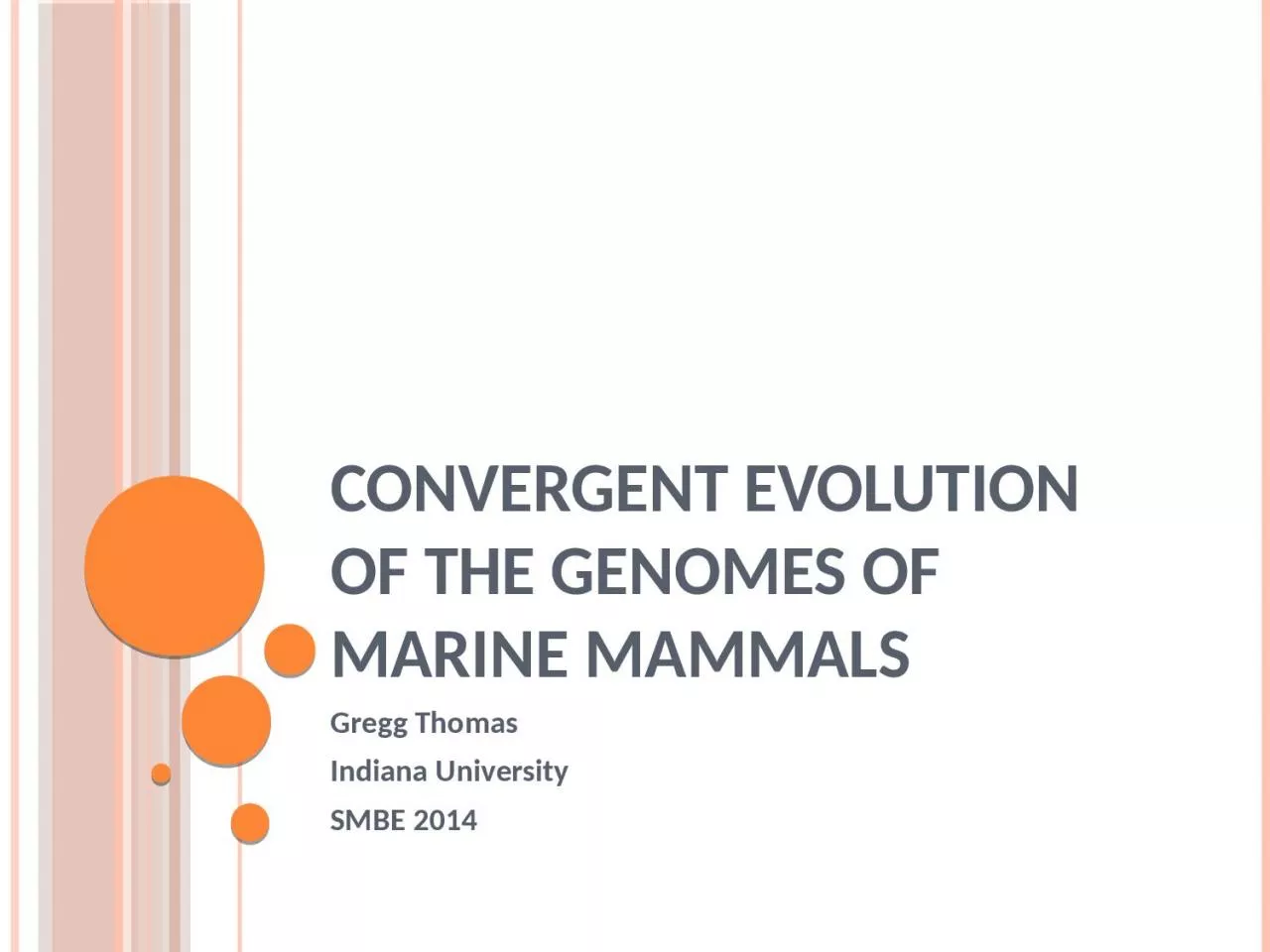

Gregg Thomas Indiana University SMBE 2014 Convergent evolution is observed at the phenotypic level Porcupine Rodentia Echidna Monotremata Hedgehog Erinaceomorpha 2 Predictable Evolution ID: 930876
Download Presentation The PPT/PDF document "Convergent evolution of the genomes of m..." is the property of its rightful owner. Permission is granted to download and print the materials on this web site for personal, non-commercial use only, and to display it on your personal computer provided you do not modify the materials and that you retain all copyright notices contained in the materials. By downloading content from our website, you accept the terms of this agreement.
Slide1
Convergent evolution of the genomes of marine mammals
Gregg Thomas
Indiana University
SMBE 2014
Slide2Convergent evolution is observed at the phenotypic level
Porcupine
(
Rodentia
)
Echidna
(Monotremata)
Hedgehog
(Erinaceomorpha)
2
Slide3Predictable Evolution
If phenotypic convergence can be attributed to specific molecular changes, it would suggest that evolution is to some extent predictable
We have very few examples…
3
Slide4Phenotypic convergence can be attributed to molecular convergence
Lysozyme
(
Kornegay
et al, 1994)
Prestin
(Parker et al 2013, Li et al 2010, Liu et al 2010)
COCH
(Parker et al
2013)
Foregut fermenters
Echolocation
4
Slide5Marine mammals provide a chance to study molecular convergence
5
Slide6Convergent phenotypes of marine mammals
Hydrodynamic body structure with reduced neck length
Sensory adaptations
S
ight in low light environments
Changes in ear structure to accommodate hearing in high pressure
Changes in respiratory and cardiac patterns depending on how long and deep the animal dives
Variations in bone density based on dive depth
Insulating blubber layer
6
Slide7Marine mammal genome sequencing
16,878 orthologous protein coding genes between the four marine mammals and
ten
other
mammals
5,900
orthologs
which
are present in all 4 marine mammals and their sister land mammals (cow, dog, elephant)
7
Slide8Detecting molecular convergence
Ancestral reconstruction implemented
in
PAML v4.7
Controlled for
CpG
sitesVarious cutoffs for confidence in ancestral sites
8
Slide9Convergent substitutions
X
X
Y
Y
Y
X
9
Slide10Simulations suggest excess convergence
Alpaca
Cow
Dolphin
Killer Whale
Dog
Walrus
Elephant
Manatee
44 convergent substitutions
10
Slide11Positively selected genes are also convergent
11
Slide12Adaptive convergent genes are related to convergent phenotypes
Gene
Function
Associated phenotype
GCLC
Glutathione metabolism
Antioxidation during long dives
S100a9
Calcium binding
Bone formation
Mgp
Calcium binding
Bone formation
Smpx
Inner ear formation
Separation of the auditory bulla from the skull in the inner ear
Myh7b
Cardiac muscle formation
Cardiovascular regulation during diving
Serpinc1
Blood coagulation
Low flow rate of viscous blood particularly during diving
12
Slide13Molecular convergence has been demonstrated
Phenotypic convergence can be inferred on a genome wide scale at the molecular level
But another comparison can be made…
13
Slide14Marine mammal convergence
Alpaca
Cow
Dolphin
Killer Whale
Dog
Walrus
Elephant
Manatee
14
Slide15Land mammal convergence
Alpaca
Cow
Dolphin
Killer Whale
Dog
Walrus
Elephant
Manatee
15
Slide16Expectations for molecular convergence in land mammals
Any molecular convergence observed should be due to chance
There should be less convergence than we found for marine mammals
16
Slide17Convergent substitutions in land mammals
Alpaca
Cow
Dolphin
Killer Whale
Dog
Walrus
Elephant
Manatee
93 convergent substitutions
17
Slide18Simulations suggest excess
convergence even among land mammals
93 convergent substitutions
18
Alpaca
Cow
Dolphin
Killer Whale
Dog
Walrus
Elephant
Manatee
Slide19Land mammals have more convergence than marine mammals
19
Alpaca
Cow
Dolphin
Killer Whale
Dog
Walrus
Elephant
Manatee
Slide20Positive selection comparable between marine and land mammals
Marine Mammals
Land Mammals
20
Slide21Genes can have more than one convergent site
= convergent substitution
21
Slide22Genes with multiple convergent sites are more prevalent in land mammals
22
Slide23What we have learned from marine mammals
Some intriguing genes linking molecular and phenotypic convergence
Surprisingly, just as much molecular convergence among land mammals
Simulations do not fully account for background convergence
23
Slide24What we have learned from marine mammals
Some intriguing genes linking molecular and phenotypic convergence
Surprisingly, just as much molecular convergence among land mammals
Simulations do not fully account for background convergence
24
Slide25Simulations do not provide an adequate null model
Difference between observed and simulated numbers of convergent substitutions
Value =
(% observed - % simulated)
Manatee
Elephant
Walrus
Dog
Cow
Killer Whale
Dolphin
Alpaca
Rat
Mouse
Marmoset
Baboon
Macaque
Human
Manatee
Elephant
Walrus
Dog
Cow
Killer Whale
Dolphin
Alpaca
Rat
Mouse
Marmoset
Baboon
Macaque
Human
25
Slide26Simulations do not provide an adequate null model
Manatee
Elephant
Walrus
Dog
Cow
Killer Whale
Dolphin
Alpaca
Rat
Mouse
Marmoset
Baboon
Macaque
Human
Manatee
Elephant
Walrus
Dog
Cow
Killer Whale
Dolphin
Alpaca
Rat
Mouse
Marmoset
Baboon
Macaque
Human
26
Slide27Molecular convergence of echolocation
Echolocatin
g
Echolocatin
g
27
Slide28Molecular convergence of echolocation
Echolocatin
g
Echolocatin
g
Non-
echolocating
28
Slide29Convergence and echolocation genes
2525
29
Slide30Convergence and echolocation genes
2525
Prestin
OTOF COCH
30
Slide31Convergence and echolocation genes
Prestin
OTOF COCH
31
Slide32Conclusions
Phenotypic convergence can be attributed to molecular convergence, but this is rare
Simulations do not provide an adequate null model for convergence
Our results suggest that evolution is not easily predictable
32
Slide33Acknowledgements
Matt Hahn
Collaborators:
Andy Foote
Kim WorleyTomas Vinar
Colleagues:James PeaseSimo
ZhangFabio MendesRafael GuerreroMelissa ToupsJeff Adrion
Genome Assembly
Yue Liu
Jixin
Deng
Carson
Qu
Sequencing
Project Managers
Vandita
Joshi
Shannon Dugan
Sequencing
Ziad
Khan
Christie Kovar
Sandra Lee
Donna
Muzny
RNAseq
analysis
Xiang Qin
Tissue Samples for Dolphin
Annalaura
Mancia
Manatee Sequencing
Kerstin
Lindblad-Toh
Jessica
Alföldi
Tissue samples for walrus and killer whale
Nils van Elk
Multi-genome alignment
Brian J. Raney
Bioinformatics and statistical support
Rasmus
Nielsen
Nagarjun
Vijay
Jochen
Wolf
Principal Investigators
Richard Gibbs
Thomas Gilbert
33
Images:
P:Yellowstone
Digital Slide
File, E: australiazoo.com,
H: instagram.com/
biddythehedgehog
,
H: amazonwiki.org, E:
asu.edu,
D:
jlhweb.net/BOSS/AKCstandard.html,
B: John Gould from The Zoology of the Voyage of H.M.S. Beagle